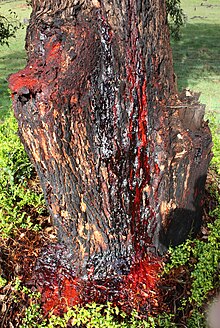Kino (botany)


Kino is a
Composition
Astringent tannin compounds are a major active component of kinos.[5] The chief constituent of kino is kinotannic acid, of which it contains 70 to 80 per cent. It also contains kino red, a phlobaphene produced from kinotannic acid by oxidation.[6] Kino also yields kinoin, a crystalline neutral principle.[7]
In cold water it is only partially dissolved, leaving a pale
When exuding from the tree, it resembles
Applications and sources

Kinos are used in medicine, tanning,
Kino is not absorbed at all from the stomach and only very slowly from the intestine. The drug was frequently used in
As they are usually soluble in water, kinos found use in traditional remedies: Eucalyptus kino is used by Aboriginal Australians in a tea for treating colds.[8]
Kino was employed to a considerable extent in the East Indies as a cotton dye, giving to the cotton the yellowish-brown color known as nankeen.[10]
Notes
- ^ A Critical Revision of the Genus Eucalyptus
- )
- S2CID 213433682, retrieved 2020-12-06
- ISBN 978-3-642-72536-4(Reprint), p. 44 f, 50 f.
- ^ ISBN 0-19-860046-1
- ^ Kino on www.henriettesherbal.com
- ^ a b c d e Chisholm, Hugh, ed. (1911). . Encyclopædia Britannica (11th ed.). Cambridge University Press.
- ^ ISBN 978-1-921719-05-9, p. 104.
- ^ a b Reynolds, Francis J., ed. (1921). . Collier's New Encyclopedia. New York: P. F. Collier & Son Company.
- ^ New International Encyclopedia(1st ed.). New York: Dodd, Mead.
- ISBN 978-1-8770-5894-3, p. 75–78.
- The American Cyclopædia.
References
Further reading
- Jean H. Langenheim. Plant Resins: Chemistry, Evolution, Ecology, and Ethnobotany (2003).
External links
- . Encyclopedia Americana. 1920.
